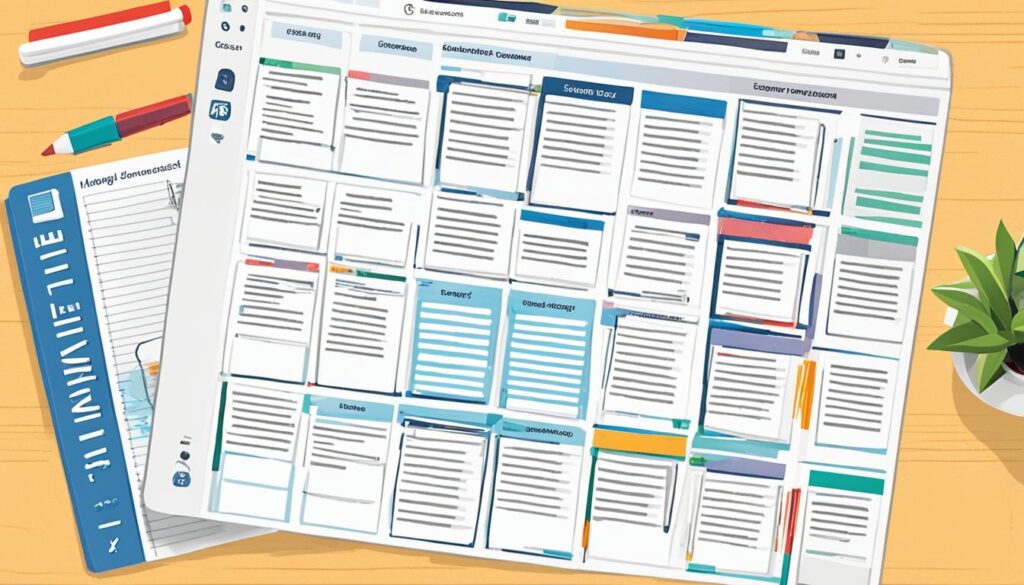Email management is a crucial aspect of education systems, offering numerous benefits for both students and educators. By effectively managing their email accounts, educational institutions can streamline communication, improve productivity, and enhance the learning experience.
Are you struggling with email overload and feeling overwhelmed by the constant influx of messages? In today’s fast-paced educational environments, staying organized and efficient is key. That’s where email management for education comes in.
With proper email organization for schools, you can regain control over your inbox and ensure that important messages are not lost in the sea of emails. By implementing email productivity strategies, you can optimize your workflow, save time, and focus on what truly matters – educating and inspiring students.
Teachers, administrators, and support staff can benefit greatly from email efficiency techniques. By implementing best practices for email management, you can effectively handle student inquiries, collaboration requests, and important announcements, all while maintaining a healthy work-life balance.
Ready to discover how to optimize your email management in education? Let’s explore some practical strategies and best practices that will help you stay organized, improve productivity, and enhance your overall teaching experience.
The Power of Email Account Management in Education
Educational institutions often provide students and staff with their own email accounts. These accounts, powered by platforms like Google, offer a range of features and tools that are not always fully utilized. By maximizing the use of email account management features, such as setting up aliases and utilizing filters, you can better organize your emails and improve efficiency.
One email management best practice is to set up aliases. Aliases are alternate email addresses associated with your main email account. They can be used to create separate email identities for different purposes, such as class assignments, extracurricular activities, or administrative tasks. By using aliases, you can categorize and filter incoming emails more effectively, ensuring that important messages are not lost or overlooked.
Another effective strategy is to use filters. Filters allow you to automatically sort incoming emails based on specific criteria, such as sender, subject, or keywords. For example, you can create a filter to automatically move emails from your professors to a designated folder or label them with a specific tag. By implementing filters, you can reduce clutter in your inbox and focus on the emails that require your immediate attention.
Benefits of Effective Email Account Management in Education
- Improved organization: By utilizing email account management features, you can keep your inbox organized and easily locate important messages.
- Time savings: Efficient email management practices help you save time by automating repetitive tasks and prioritizing important emails.
- Enhanced productivity: By reducing the time spent searching for emails or dealing with unnecessary clutter, you can focus more on your academic responsibilities.
- Extended post-graduation access: Many educational email accounts provide extended access even after graduation, allowing you to maintain important contacts and access valuable resources.
- Student discounts and offers: Educational email accounts often come with exclusive student discounts and offers on software, subscriptions, and other educational resources.
By effectively managing your email account, you can unlock its full potential and make your academic journey more streamlined and efficient. Take advantage of the features and tools available to you, and discover the benefits that effective email management can bring to your education.
Here’s a Quote for Inspiration:
“Email management is not just about keeping your inbox tidy; it’s about optimizing your communication and maximizing your productivity. Take control of your email account and experience the power of efficient email management in education.”
Streamlining Email Communication in Education
In the realm of education, effective email management is essential for streamlining communication and ensuring important information reaches the intended recipients in a timely manner. By implementing best practices, educators and administrators can save time, improve productivity, and enhance collaboration. Students can also benefit from email management strategies, allowing them to stay organized and reduce the risk of missing important deadlines or announcements.
Prioritizing Unread Emails
One effective strategy for managing emails in education is to prioritize unread emails. By focusing on unread messages first, educators and administrators can quickly address urgent matters and stay up-to-date with the latest information. This helps prevent important emails from getting buried in a cluttered inbox.
Using Labels and Filters
Labels and filters are powerful tools that can be utilized to categorize and organize emails. By creating labels and applying them to specific emails or conversations, educators and administrators can easily find and sort messages based on different criteria such as importance, subject, or sender. Filters can automatically route incoming emails to specific folders or apply labels, further streamlining the organization process.
Automating Certain Tasks
Automation can significantly improve email productivity for educators. By setting up rules or filters, routine tasks such as forwarding emails, archiving, or categorizing can be automated. For example, educators can create a rule to automatically forward emails related to a specific project or committee to the appropriate recipient, saving time and ensuring efficient communication.
“Implementing best practices for managing emails in education can save valuable time and enhance collaboration between educators, administrators, and students.”
By implementing these email management strategies, educators can optimize communication and ensure important information reaches the right individuals in a timely manner. Students can also benefit by staying organized and reducing the risk of missing critical information. By streamlining email communication in education, schools can create a more productive and efficient learning environment.
| Email Management Strategies | Benefits |
|---|---|
| Prioritizing Unread Emails | Saves time and ensures urgent matters are addressed promptly |
| Using Labels and Filters | Enables easy organization and categorization of emails |
| Automating Certain Tasks | Increases efficiency by automating routine email management tasks |

Centralized Communication Systems in Remote Learning
With the shift towards remote learning, centralized communication systems have become essential tools for educational institutions. These systems consolidate all communication channels into a single platform, facilitating clear and efficient information flow. Centralized communication platforms enable real-time collaboration, accessibility, and flexibility, fostering interactive learning experiences and providing dedicated spaces for student support. By leveraging the features of these systems, educational institutions can create a sense of virtual community and enhance the overall remote learning experience.
| Benefits of Centralized Communication Systems in Remote Learning |
|---|
| Improved Information Flow |
| Enhanced Collaboration |
| Increased Accessibility |
| Flexible Learning Environment |
| Dedicated Spaces for Student Support |
One of the key benefits of centralized communication systems in remote learning is the improved information flow. By consolidating all communication channels, such as emails, messages, and announcements, into one platform, educators can ensure that important information reaches students in a timely manner.
Additionally, these systems enable enhanced collaboration among students and educators. Real-time communication tools, discussion boards, and virtual classrooms facilitate interactive learning experiences and encourage active participation.
Centralized communication platforms also increase accessibility by providing a single point of access for students. With all resources and communications in one place, students can easily navigate through the learning materials and stay organized.
Furthermore, these systems create a flexible learning environment by allowing students to access the platform from anywhere, at any time. This flexibility caters to the diverse needs and schedules of students, supporting their individual learning journeys.
Lastly, centralized communication systems offer dedicated spaces for student support. Whether it’s through virtual office hours, online forums, or direct messaging with educators, these platforms foster a sense of community and provide avenues for students to seek guidance and assistance.

By implementing centralized communication systems in remote learning, educational institutions can effectively manage communication, promote collaboration, and create a thriving virtual learning community. These platforms play a crucial role in enhancing the overall remote learning experience for both educators and students.
eBook eLearning and its Impact on Education
The integration of eBook eLearning into Learning Management Systems (LMS) has revolutionized education. eBooks offer dynamic, multimedia-rich content that can be accessed anytime, anywhere, breaking down geographical barriers and accommodating diverse learning styles. Through the use of interactive elements, videos, and assessments, eBook eLearning enhances engagement, fosters active learning, and provides personalized learning experiences.
By leveraging the power of LMS platforms, educational institutions can optimize eBook eLearning to deliver an exceptional educational experience. Here are some key features and best practices for maximizing the impact of eBook eLearning:
- User-centric design: Create intuitive and user-friendly interfaces that prioritize ease of navigation and accessibility for learners.
- Responsive design: Ensure that the eBook content is compatible and adaptable to various devices, including desktops, tablets, and smartphones.
- Multimedia integration: Incorporate engaging multimedia elements such as images, videos, and interactive simulations to enhance understanding and retention of complex concepts.
- Assessment integration: Embed formative and summative assessments within the eBook to provide immediate feedback and track learner progress.
- Collaborative features: Enable social learning and collaboration by integrating discussion boards, group projects, and peer feedback options.
- Personalization options: Customize the eBook content and learning paths based on individual learner preferences, pace, and proficiency level.
- Data analytics: Utilize data tracking and analysis tools to gain insights into learner behavior, engagement, and performance, enabling targeted interventions and continuous improvement.
By implementing these best practices, educational institutions can harness the full potential of eBook eLearning, enabling a more interactive, engaging, and personalized learning journey for students.

| Key Benefits of eBook eLearning | Primary Impact on Education |
|---|---|
| 1. Accessible learning material for students regardless of location and time | Enhanced accessibility, breaking down geographical barriers |
| 2. Multimedia-rich content that caters to diverse learning styles | Accommodation of different learning preferences and engagement |
| 3. Interactive elements and assessments that foster active learning | Increased engagement and understanding of concepts |
| 4. Personalized learning experiences tailored to individual student needs | Ensured learner-centric approach and improved student outcomes |
| 5. Real-time tracking and analytics for progress monitoring | Informed decision-making and targeted interventions |
Conclusion
Effective email management is a crucial factor in optimizing the learning experience in educational settings. By harnessing the features and tools provided by email account management systems, educational institutions can greatly enhance efficiency and organization. Implementing centralized communication systems further amplifies remote learning experiences by facilitating a smooth flow of information, fostering real-time collaboration, and unlocking enhanced accessibility.
The integration of eBook eLearning within Learning Management System (LMS) platforms presents a dynamic and engaging approach to education. This integration empowers educators to deliver personalized content that promotes active learning. Utilizing interactive elements, multimedia resources, and integrated assessments, eBook eLearning caters to diverse learning styles and contributes to a more immersive educational journey.
As technology continues to advance, the adoption of these email management and eLearning strategies will shape the future of education. This evolution will propel productivity and revolutionize the learning experience for both students and educators. By embracing email management for education, educational institutions can optimize communication, organization, and productivity, ultimately creating an environment that nurtures growth and fosters success.
FAQ
How can email management enhance learning in educational settings?
By effectively managing email accounts, educational institutions can streamline communication, improve productivity, and enhance the learning experience. It allows for better organization of emails, reduces the risk of missing important information, and enables timely communication with students, staff, and administrators.
What are some best practices for email account management in education?
Some best practices include prioritizing unread emails, using labels and filters to categorize emails, setting up aliases for different purposes, and automating certain tasks. These strategies help educators and administrators save time, stay organized, and improve efficiency in their communication.
How does a centralized communication system benefit remote learning in education?
Centralized communication systems consolidate all communication channels into a single platform, making information flow clearer and more efficient. These systems enable real-time collaboration, provide dedicated spaces for student support, and create a sense of virtual community, enhancing the overall remote learning experience.
What is eBook eLearning and how does it impact education?
eBook eLearning is the integration of eBooks into Learning Management Systems (LMS). eBooks offer dynamic, multimedia-rich content that can be accessed anytime, anywhere, accommodating diverse learning styles. Through interactive elements, videos, and assessments, eBook eLearning enhances engagement, fosters active learning, and provides personalized learning experiences.
How can email management systems optimize the use of eBook eLearning?
Email management systems can optimize eBook eLearning within LMS platforms by prioritizing user-centric design, responsive design, multimedia integration, assessment integration, collaborative features, personalization options, and data analytics. These features enhance the overall learning experience and promote active and personalized content.
